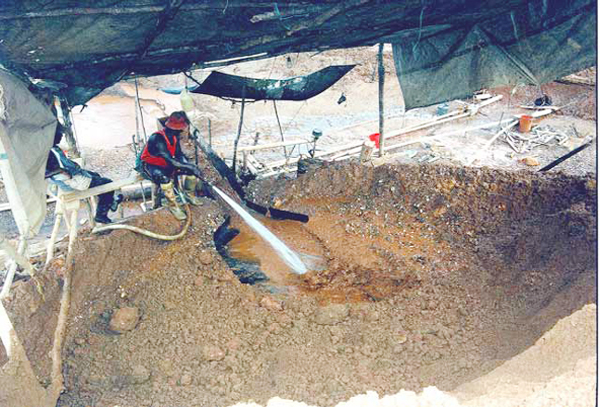– questions claims that mercury use by miners has created widespread environmental damage
Executive Secretary of the Guyana Gold and Diamond Miners Association (GGDMA) Edward Shields has reacted cautiously to reports that the use of mercury in the gold mining industry is being phased out.

Speaking with Stabroek Business earlier this week Shields said while he was aware of media reports alluding to the eventual cessation of the use of mercury in the gold recovery process he was not aware that there had been any gold-recovery methodology that had been specifically identified to replace what has traditionally been the widespread use of mercury in the local gold-mining sector.
More than three months ago, Shields had said in an interview with this newspaper that the local gold mining sector was not wedded to mercury adding that he believed that miners would be open to alternative methods of gold recovery that made business sense. During this week’s interview Shields restated this position. “I have said before that miners are not wedded to mercury use. Whenever the scientists and the powers that be come up with a viable alternative that allows mining to do done economically the miners with apply that alternative. The industry has no addiction to mercury.”
Shields told Stabroek Business, however, that the GGDMA would be concerned about any unilateral move to bring an end to mercury use in the mining sector.
“Banning the use of mercury in the mining sector in Guyana could turn out to be no more than a legal development. The obvious result will be that the cost of obtaining mercury will increase because miners will continue to use mercury as long as there is no viable alternative. Any unilateral action will result in chaos in the mining industry,” Shields added.
The GGDMA Head told Stabroek Business that he questioned whether or not the authorities had the resources at their disposal to ensure the effective policing of a ban on mercury use. “The reality is that if we do not, even now, have the resources to prevent delinquent miners from placing mercury in their sluice boxes, the question arises as to who will police the effective application of a ban on mercury use.”
Shields said that he was aware of demonstrations currently being carried out in the Mahdia area in the use of Shaking Tables and Concentrators as possible alternatives to mercury use. He disclosed that over the past three months environmental officers attached to the GGMC, the GGDMA and GEMCAP have been working with miners not only on seeking alternatives to mercury use but also on the rehabilitation of mined out areas.
Asked whether the local mining industry had been showing an interest in mercury-free mining methods that have been adopted in French Guiana, Shields told Stabroek Business that comparisons with the mining sector in French Guiana were likely to be misleading since the situation in the industry there was different. “Apart from the fact that there are far fewer miners in the industry in French Guiana, mining there yields an average of two kilos of gold per day. Here in Guyana the yield per day is measured in terms of ounces and therefore mercury becomes all the more important in the gold recovery process.”
Meanwhile, the GGDMA Executive Secretary told Stabroek Business that he takes issue with the view that the use mercury by miners had been responsible for widespread pollution in mining areas. “This issue has been with us for many years. I am aware that a number of agencies including the World Wildlife Fund, GEMCAP, the Guyana Geology and Mines Commission and various environmental agencies have been involved in testing for mercury pollution. Despite all the testing and the studies, however, no area has so far been closed down as a result of mercury pollution. I can only conclude that there has not been any evidence to warrant such action. Interestingly, the people who are most vulnerable to being harmed by mercury are the miners themselves, if they do not use the proper retorts. Why should they want to harm themselves? If there are safer options why should the miners not embrace them?” Shields asked.
Shields told Stabroek Business that he believed it was necessary to separate the use of mercury in the mining sector from mercury pollution adding that he did not believe that there was any strong evidence to support claims that the mining sector was responsible for mercury pollution.
“There are legal requirements that attend the use of mercury in the mining sector and if mercury is used by miners in accordance with the law it then becomes necessary to use only minimum amounts of the substance. The GGDMA has made it clear that it is thoroughly against what we believe is a practice among some miners to use mercury in their sluice boxes and their pits,” Shields added.
Asked whether as far as he was aware a time frame had been established for the phasing out of mercury in the mining sector Shields said he was not aware of such a time frame. “There cannot be a time frame because there is no objective marker as to when an acceptable alternative will materialize.
It can happen in a matter of months if an acceptable alternative emerges. The point is that if you ban the use of a substance that is at the core of an operation you have to have an appropriate substitute. Otherwise what you are in fact doing is closing down the sector.”

